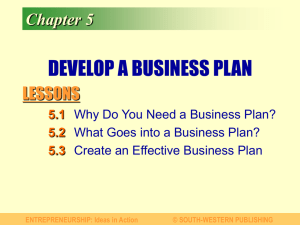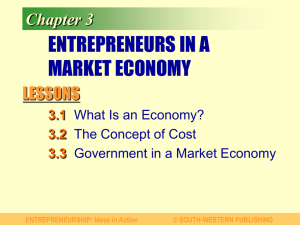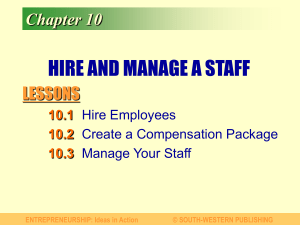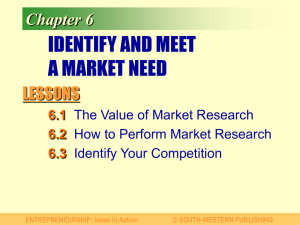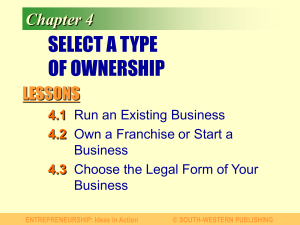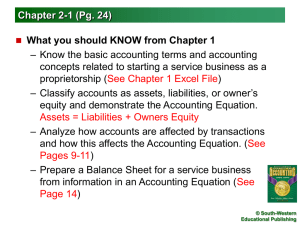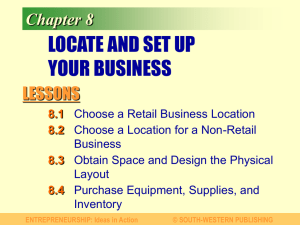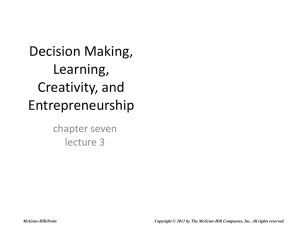Chapter 7 FINANCE, PROTECT, AND INSURE YOUR BUSINESS
advertisement
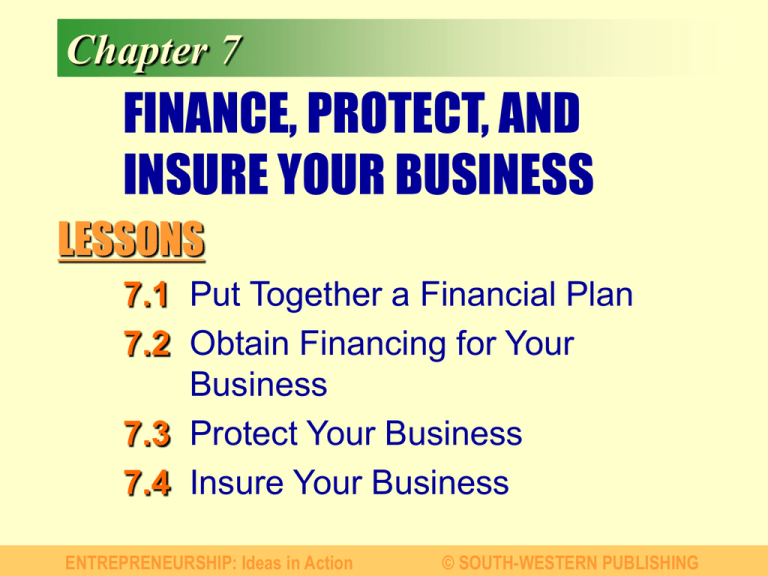
Chapter 7 FINANCE, PROTECT, AND INSURE YOUR BUSINESS LESSONS 7.1 Put Together a Financial Plan 7.2 Obtain Financing for Your Business 7.3 Protect Your Business 7.4 Insure Your Business ENTREPRENEURSHIP: Ideas in Action © SOUTH-WESTERN PUBLISHING Chapter 7 Slide 2 Lesson 7.1 PUT TOGETHER A FINANCIAL PLAN GOALS Calculate your start-up costs. Create a cash flow statement, an income statement, a balance sheet, and a personal financial statement. ENTREPRENEURSHIP: Ideas in Action © SOUTH-WESTERN PUBLISHING Chapter 7 Slide 3 PREPARE FINANCIAL STATEMENTS List of start-up costs Cash flow statement Income statement Balance sheet Personal financial statement ENTREPRENEURSHIP: Ideas in Action © SOUTH-WESTERN PUBLISHING Chapter 7 Slide 4 START-UP COSTS Start-up costs are the one-time-only expenses that are paid to establish a business. Common start-up costs include: Equipment and supplies Furniture and fixtures Vehicles Remodeling Legal and accounting fees Licensing fees ENTREPRENEURSHIP: Ideas in Action © SOUTH-WESTERN PUBLISHING Chapter 7 Slide 5 CASH FLOW STATEMENT A cash flow statement describes how much cash comes in and goes out of a business over a period of time. Forecast revenues Forecast operating expenses Prepare the cash flow statement Best and worst case ENTREPRENEURSHIP: Ideas in Action © SOUTH-WESTERN PUBLISHING Chapter 7 Slide 6 INCOME STATEMENT An income statement is a financial statement that indicates how much money a business earns or loses during a particular period. Also known as a profit and loss statement Difference from a cash flow statement ENTREPRENEURSHIP: Ideas in Action © SOUTH-WESTERN PUBLISHING Chapter 7 Slide 7 BALANCE SHEET Types of assets Types of liabilities Uncollectible accounts Depreciation ENTREPRENEURSHIP: Ideas in Action © SOUTH-WESTERN PUBLISHING Chapter 7 Slide 8 PERSONAL FINANCIAL STATEMENT A personal financial statement is a balance sheet of your holdings. It shows your personal assets, liabilities, and net worth. ENTREPRENEURSHIP: Ideas in Action © SOUTH-WESTERN PUBLISHING Chapter 7 Slide 9 Lesson 7.2 OBTAIN FINANCING FOR YOUR BUSINESS GOALS Consider different types of bank loans. Explain Small Business Administration loans. Evaluate other sources that can provide debt capital. ENTREPRENEURSHIP: Ideas in Action © SOUTH-WESTERN PUBLISHING Chapter 7 Slide 10 BANK LOANS Types of bank loans Secured loans Unsecured loans Types of secured loans Line of credit Short-term loan Long-term loan ENTREPRENEURSHIP: Ideas in Action © SOUTH-WESTERN PUBLISHING REASONS A BANK MAY NOT LEND MONEY Chapter 7 Slide 11 The business is a start up Lack of a solid business plan Lack of adequate experience Lack of confidence in the borrower Inadequate investment in the business ENTREPRENEURSHIP: Ideas in Action © SOUTH-WESTERN PUBLISHING SMALL BUSINESS ADMINISTRATION LOANS Chapter 7 Slide 12 SBA loan assistance Requirements of SBA loans Apply for an SBA loan ENTREPRENEURSHIP: Ideas in Action © SOUTH-WESTERN PUBLISHING Chapter 7 Slide 13 REQUIREMENTS OF SBA LOANS Your business must be considered a small business. Your business must not be the leader in its field. Your business must comply with all federal employment laws. Your business cannot create or distribute ideas or opinions. You must have been unable to obtain financing from a commercial bank. You must invest a reasonable amount of your own money in the venture. You must provide adequate collateral. ENTREPRENEURSHIP: Ideas in Action © SOUTH-WESTERN PUBLISHING Chapter 7 Slide 14 OTHER SOURCES OF LOANS Small Business Investment Companies— SBIC Minority Enterprise Small Business Investment Companies—MESBIC Department Of Housing And Urban Development—HUD Economic Development Administration—EDA State governments Local and municipal governments ENTREPRENEURSHIP: Ideas in Action © SOUTH-WESTERN PUBLISHING FINANCE YOUR BUSINESS WITH EQUITY CAPITAL Chapter 7 Slide 15 Equity capital is money invested in a business in return for a share in the business’s profits. Sources of equity Personal financing Friends and family Venture capitalist ENTREPRENEURSHIP: Ideas in Action © SOUTH-WESTERN PUBLISHING Chapter 7 Slide 16 Lesson 7.3 PROTECT YOUR BUSINESS GOALS Categorize business risk. Identify security precautions to protect your business from different types of theft. ENTREPRENEURSHIP: Ideas in Action © SOUTH-WESTERN PUBLISHING Chapter 7 Slide 17 BUSINESS RISK Human risks Natural risks Economic risks ENTREPRENEURSHIP: Ideas in Action © SOUTH-WESTERN PUBLISHING Chapter 7 Slide 18 SHOPLIFTING Shoplifting is the act of knowingly taking items from a business without paying. Customers shoplift millions of dollars in merchandise every year. ENTREPRENEURSHIP: Ideas in Action © SOUTH-WESTERN PUBLISHING Chapter 7 Slide 19 EMPLOYEE THEFT Procedures for preventing and detecting employee theft include: Prevent dishonest employees from joining your company. Install surveillance systems. Establish a tough company policy regarding employee theft. Be on the lookout. ENTREPRENEURSHIP: Ideas in Action © SOUTH-WESTERN PUBLISHING Chapter 7 Slide 20 OTHER TYPES OF THEFT Robbery Credit card fraud Bounced checks ENTREPRENEURSHIP: Ideas in Action © SOUTH-WESTERN PUBLISHING Chapter 7 Slide 21 Lesson 7.4 INSURE YOUR BUSINESS GOALS Determine the different types of insurance you may need for your business. Purchase insurance. ENTREPRENEURSHIP: Ideas in Action © SOUTH-WESTERN PUBLISHING Chapter 7 Slide 22 CLASSIFICATION OF RISK Result of the risk Control of the risk Insurability of risk ENTREPRENEURSHIP: Ideas in Action © SOUTH-WESTERN PUBLISHING Chapter 7 Slide 23 TYPES OF INSURANCE Property insurance Casualty insurance Life insurance Workers’ compensation Other kinds of insurance ENTREPRENEURSHIP: Ideas in Action © SOUTH-WESTERN PUBLISHING Chapter 7 Slide 24 BUY INSURANCE Choose an insurance agent Determine how much coverage you need ENTREPRENEURSHIP: Ideas in Action © SOUTH-WESTERN PUBLISHING
